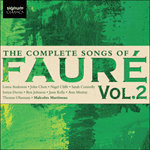The song was written for Emilie Girette, later wife of the pianist Edouard Risler, and one of the many singing beauties who inspired the composer over the years to song composition. It is another Samain setting, the composer’s third and last dalliance with this poet, and among the least performed of all Fauré’s mélodies. Less obviously voluptuous than
Pleurs d’or, it shows the composer on the border of his third period. The music has all the harmonic complexity of Fauré’s late style, but it has yet to achieve the transparency and lucidity of the four final cycles. This extended mélodie is best understood as a series of pictures, each reflecting the composer’s lifelong virtuosity with musical imagery depicting water. The first of these (the poem’s opening five lines) is accompanied by pulsating mezzo staccato quavers, ever changing yet somehow immobile—a perfect musical description of shimmering moonlight on the flat and mirror-like surface of ‘Le grand lac parfumé’. In the next seven lines the singer plies his oar in ‘broad slow swooning strokes’. Each plunge in
forte quavers and triplets sets off a series of subsidiary ripples in
piano semiquavers. The next two strophes (from ‘Là-bas la lune écoute’) inspire yet another pattern: limpid sextuplets spiral between the pianist’s hands, and from the lower stave to the higher, a miracle of teeming uneventfulness, the gliding of the boat in unearthly silence. This is water music, simultaneously nocturne and barcarolle, whose upward drift is also redolent of the fragrance of the lilies mentioned in the text. The final strophe of the poem is set to the music of the opening as both moon and poet’s oar touch the surface of the water. The vocal line is neither melody nor recitative, but a continually evolving combination of the two—pure music that simplifies an over aesthetic text. If the song as a whole is not one of Fauré’s greatest, it contains ample evidence of his own greatness.
from notes by Graham Johnson © 2005
Cette pièce fut écrite pour Émilie Girette (future épouse du pianiste Édouard Risler), l’une de ces nombreuses beautés chantantes qui inspirèrent, au fil des ans, tant de mélodies à Fauré. Mise en musique d’un texte de Samain—troisième et ultime badinage de notre compositeur avec ce poète—, elle compte parmi les mélodies fauréennes les moins interprétées. Moins ostensiblement voluptueuse que
Pleurs d’or, elle montre Fauré à la lisière de sa troisième manière: la musique renferme déjà toute la complexité harmonique du style tardif, mais il lui manque encore la transparence et la lucidité des quatre cycles finals. Cette musique étendue n’est jamais mieux appréhendée que sous la forme d’une série de tableaux, chacun reflétant l’indéfectible virtuosité du compositeur par une imagerie musicale aquatique. Le premier de ces tableaux (les cinq premiers vers du poème) est accompagné de croches mezzo staccato battantes, toujours changeantes mais, d’une certaine manière, immobiles—le parfait portrait musical d’un clair de lune brasillant sur la surface étale, lisse comme un miroir, de «le grand lac parfumé». Les sept vers suivants voient le chanteur ramer en «de larges et lents coups langoureux». Chaque plongée dans des croches et des triolets
forte déclenche une série d’ondulations auxiliaires en doubles croches
piano. Les deux strophes suivantes (à partir de «Là-bas la lune écoute») inspirent encore un autre schéma: de limpides sextolets vrillent entre les mains du pianiste et, de haut en bas de la portée, un miracle de tranquillité débordante—le glissement du bateau dans un silence surnaturel. C’est une musique aquatique, tout à la fois nocturne et barcarolle, dont la dérive ascendante rappelle aussi la fragrance des lys mentionnés dans le texte. L’ultime strophe du poème reçoit la musique de l’ouverture, au moment où la lune et la rame du poète entrent en contact avec l’eau. La ligne vocale n’est ni une mélodie ni un récitatif, mais une combinaison des deux, en constante évolution—une musique pure qui simplifie un texte par trop esthétique. Si, globalement parlant, cette mélodie n’est pas l’une des plus grandes de Fauré, elle n’en recèle pas moins d’abondantes preuves du grandiose de ce compositeur.
extrait des notes rédigées par Graham Johnson © 2005
Français: Hypérion


 Fauré: The Complete Songs, Vol. 2
Fauré: The Complete Songs, Vol. 2
